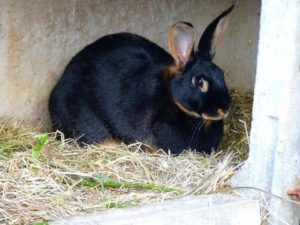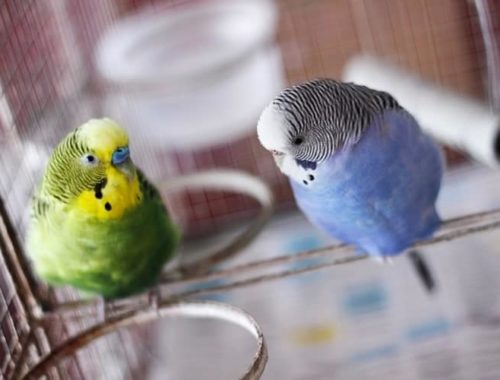Are you considering getting a bunny as a pet? Bunnies make popular pets because they’re quiet, they don’t take up much space, and they bond with their owners. Rabbits can be trained and they’re fairly low-maintenance, as far as pets go: You won’t have to walk your bunny and they do just as well in apartments as they do in larger homes. If you are ready to take the next step and get a rabbit of your very own, read on to learn how to best take care of your new pet.
How to Set Up for Your Bunny

- Bunny-proof your home. If you will be letting your bunny roam around the house, you will need to make your home safe for him.
- Cover any wires or cords. Bunnies love to chew, and this can cause electrocution. Move the cords you can and cover the rest with flexible tubing.
- Use a baby gate to section off areas where your bunny may and may not go. You might choose to keep him in one room, such as the kitchen, or to block off his access to a carpeted room, such as a formal living room.
- Place poisonous houseplants well out of your bunny’s reach. Tulips, holly, poinsettia, and tomato leaves are toxic to rabbits.
- Set up your bunny’s habitat. You will need to choose an appropriate cage or hutch and fill it with the correct bedding and accessories.
- Look for a cage or hutch that will accommodate your bunny’s adult size. Your bunny should be able to take three hops in one direction while in his cage. If the cage has a wire bottom, buy a piece of wood to cover the bottom; rabbits should not be sitting on wires. Also, the cage should have a urine guard around the bottom, because bunnies spray when they urinate.
Looking for some outdoor rabbit hutch options? See our full list of The Best Outdoor Rabbit Hutches.
-
- Place a litter box, preferably a triangular one, in one corner of the cage. Use newspaper or rabbit litter in the box – never clumping cat litter, which is toxic to bunnies. Cover the paper or litter with hay.
- Line the cage with six inches or more of bedding. Straw or hay is the best type of bedding, but you can also use commercial paper bedding.
- Place a heavy-bottomed food dish in the corner of the cage opposite the litter box. Hang a water bottle near the food, but not so near that it can drip into the food.
- Go shopping for the additional items you need. Your new bunny will need a brush and a nail clipper. You might also like to give him some wooden toys to nibble on and a tunnel to hide in. Your bunny might also enjoy a small cardboard box filled with shredded newspaper in which to dig and hide.
How to Feed Your Bunny
- Choose high-quality rabbit pellets. Look for pellets that are high in fiber (18% or more) and only buy a month’s supply at a time so it doesn’t go stale.
- Buy hay for your bunny. As your bunny gets older, the mainstay of her diet will be hay. Young bunnies will eat some alfalfa hay along with timothy hay, grass hay, or oat hay, but as she gets older, decrease the alfalfa hay and focus on the others. It should be available 24 hours per day.
- Include fresh vegetables in your bunny’s diet. Introduce root and leafy green veggies slowly. An adult rabbit should eat two cups or more of chopped leafy vegetables with a small amount of carrots.
- Use treats sparingly. A small amount of fruit like apples, bananas, or pineapple chunks makes good treats for your bunny.
- Have fresh water available at all times. Wash out your bunny’s water bottle daily. Make sure it’s filled with fresh water at all times.
How to Pick Up Your Bunny
- Move slowly and calmly. The main danger in picking up your bunny is that he will panic and hurt himself in an effort to get away. It’s important to move slowly and to speak calmly to him as you approach. If he backs away, don’t force the issue; just wait a little while and try again.
- Stay close to the ground. When you first pick up your bunny, he might flail his legs, which can result in injury. Worse, his rapid movements may cause you to drop him. Pick up your new bunny from the position of sitting on the floor so if you have to let go of him quickly, you’re already only a few inches from the ground.
- Try lifting the bunny by his chest and bottom. Place one hand under your bunny’s chest and lift his front feet off the ground. If he tolerates that well, scoop up his bottom by placing your hand under the back of his legs. Make sure that his legs are always supported.
- Try lifting the bunny by his scruff and bottom. Another way to pick up your bunny is to hold him by the scruff of the neck with the other hand under his bottom. Use his scruff more as a handle and not as the main pressure point when lifting him.
- Always use two hands. Because bunnies are skittish, it’s easy to lose your grip if they suddenly jerk in your hands. Never try to hold your rabbit with just one hand; instead, always use two to properly support your pet.
- Interact with your bunny. Give your bunny treats to let him know that being handled is something to look forward to and enjoy. Also, consider putting aside some bunny toys to play with only when he is with you. Your bunny might enjoy cardboard tubes, children’s bowling pins to knock over, or plastic baby toys to hold onto or kick around.
How to Clean Your Bunny
- Wipe out your bunny’s ears. Use a soft cloth to gently wipe out the long part of your bunny’s ears. If you notice that she has wax or debris inside of her ear canals, do not try to remove it yourself. Instead, take her to the veterinarian to have the professionals properly clean her ears without risking injury.
- Brush her fur. Use a brush to gently brush loose fur from her coat when she’s shedding. Usually, bunnies shed, or molt, several times per year, but indoor bunnies can seem to shed year-round. You don’t have to brush her every day; once per week is enough for short-haired bunnies or more frequently for long-haired bunnies.
- Trim her nails. Your bunny’s nails will grow continuously, so it’s important to keep them trimmed. Clipping them every four to six weeks should keep them at the right length. Shine a flashlight under her nails so you can see where the quick is, then clip only the very end with nail clippers, away from the quick. If you are nervous about trimming her nails, your veterinarian or a groomer can do it.
- Clean her scent glands. Your rabbit has scent glands near her anus that might need to be cleaned. If your bunny is scooting her bottom on the ground or you notice a foul odor, you can use a damp cotton swab to gently clean the area. Again, if you are uncomfortable with this, your veterinarian can do it.
- Bathe your bunny’s bottom if she is sick. Your bunny should never be immersed in water, but if she has diarrhea, you might need to bathe her bottom. (A healthy rabbit does not need a bath at all.) Use only an inch of warm water and gently clean up any debris on her bottom and legs. Dry her well with a soft towel.
How to Clean Your Bunny’s Cage
- Tidy up your bunny’s cage every day. Each day, you should clean out your bunny’s litter box, fluff up his straw bedding, replace any food left in the bowl, rinse and refill the water bottle, and throw away any chewed-up cardboard.
- Wash out the cage every week or two. A few times per month, you should clean out your bunny’s cage thoroughly.
- Put your bunny in a safe place, such as in a room with baby gates or in a puppy pen.
- Take everything out of the cage. Throw away used bedding and any chewed-up toys.
- Wash out your bunny’s food bowl, water bottle, litter box, and any other accessories you are keeping with hot, soapy water. Rinse very well and allow to dry. If your bunny has a blanket, wash it with a mild, scent-free detergent and dry it thoroughly before putting it back in the cage.
- Scrub out the cage with a solution of hot water and vinegar (white vinegar is preferred). Don’t use any chemical cleansers because these can harm your bunny. Be sure the cage is completely dry before proceeding.
- Fill the cage with fresh, clean bedding. Re-fill his litter box, food dish, and water bottle.
How to Tell If Your Bunny Is Happy and Healthy
- Check her eyes, nose, and ears. Your bunny’s eyes should be clear and bright. Her nose should not have any discharge and her ears should be clean.
- Look at her teeth. Your bunny’s teeth will grow continuously. Chewing on her toys and grinding hay will help keep them the right length. If your rabbit’s teeth are getting long enough to cover her bottom teeth, it’s possible that she’s not grinding them down enough. Take her to the veterinarian for an evaluation.
- Look at and feel her fur. Your bunny’s fur should be soft, supple, and not matted. Pet your bunny gently to be sure that there are no lumps in her skin. She should not have dandruff or scabby areas. If your pet has dry, matted fur or if you feel any lumps, dandruff, or scabs, a visit to the vet is in order.
- Monitor her bowel movements. Your bunny will have two different types of bowel movements. Cecotropes are mushy bowel movements that your bunny will eat. It sounds gross, but it’s the way a rabbit’s digestive system works. Once she digests those, her bowel movements will be drier pellets. If your bunny has loose stools or isn’t passing stool at all, call the veterinarian promptly.
- Consider her behavior. Your bunny should be active, have a healthy appetite, and be fairly friendly. A pet bunny that you’ve had for a while shouldn’t act afraid of you. If you notice changes in her behavior, contact the veterinarian.
- Watch for signs of illness. Signs of illness in a rabbit include cloudy eyes, nasal discharge, sneezing, loss of appetite, excessive grooming, a lack of bowel movements or diarrhea, swelling, and isolating herself in the corner of her cage with no interest in interaction. These are all symptoms that should be brought to the attention of your veterinarian.
With proper care and good health, your bunny will live an average of seven to ten years; some rabbits can even live up to 15 years. Be sure to talk to your veterinarian if you have any concerns about your bunny. Enjoy your new pet!
Featured Image Credit: BONDART PHOTOGRAPHY, Shutterstock





























